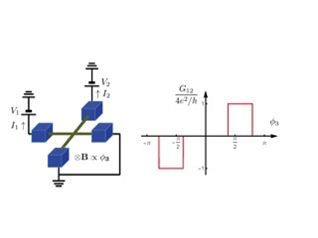The work proposes an entirely new perspective on the realization of topological quantum matter with an arbitrary dimension, an opportunity that did not seem realistic so far. Indeed, the dimension in this proposal is set by the number of superconducting terminals. Thus, it is not limited by the three-dimensional character of our physical space. A Josephson junction with n ≥ 4 terminals provides a realization of a topological material in n - 1 ≥ 3 dimensions, with the superconducting phase differences playing the role of the band-structure quasi-momenta. Such a junction can admit for a topologically protected gap closing,
i.e., a Weyl singularity, in its subgap spectrum, at energies below the superconducting gap in the leads. The presence of Weyl singularities enables topological transitions that are manifested experimentally as changes of the quantized trans-conductance. This resembles the integer quantum Hall effect, although it is based on a completely different physical mechanism. The prediction could be easily tested with conventional hybrid superconducting junctions.
The investigation of topological transitions in quantum systems is a thriving area of modern research that stretches over several different fields, from Weyl and Dirac semimetals, to unconventional superconductors and topological insulators. On the fundamental side, the occurrence of linear gap closings can serve as a playground for exploring "relativistic" physics in a low-energy regime. The prediction of Weyl singularities in superconducting hybrid nanostructures is also an important milestone in a field of research at the interface between mesoscopic superconductivity and quantum technology. Novel device concepts have been proposed, such as highly sensitive nanoSQUIDs, Cooper pair splitters as sources of entangled electrons, hybrid diodes as sources of entangled photons, Andreev quantum bits with long coherence times, Majorana edge modes for topologically protected quantum computing… All these devices require the understanding of the subgap states, known as Andreev bound states, which are localized in the junction and which have been evidenced only recently. By revealing the topological properties of the Andreev spectrum in multi-terminal Josephson junctions, the present work provides a substantial extension of possible concepts based on them, which can be envisioned in the near future.
This work was supported by the ANR and realized in the frame of the Chair of Excellence program of the Fondation Nanosciences (Grenoble).

Figure: Left: setup of a multi-terminal Josephson junction between superconducting leads (blue) connected through a normal region (green). A magnetic field controls the superconducting phase difference between two of the leads, while two others are voltage-biased.
Right: Quantization of the trans-conductance upon varying the superconducting phase difference.